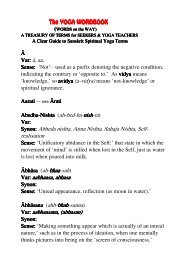Words on the Way - Muz Murray Mantra Yoga Master
Words on the Way - Muz Murray Mantra Yoga Master
Words on the Way - Muz Murray Mantra Yoga Master
Create successful ePaper yourself
Turn your PDF publications into a flip-book with our unique Google optimized e-Paper software.
Y—WORDS <strong>on</strong> <strong>the</strong> WAY<br />
Yagña (yag-nyah or yaj-nyah)<br />
Var: Yajña,yaagna, yagnya, (yaga)<br />
Syn<strong>on</strong>: Havan, homa<br />
Sense: ‘Sacrifice: ‘ a sacrificial rite of offering to God or deity.’<br />
Root: Yaj — <strong>the</strong> act of sacrificing, worshipping, or <strong>the</strong> sacrificer<br />
himself. Yaj is also said to mean ‘worship of <strong>the</strong> deity (devapuja).<br />
Ya (or Yam) is also <strong>the</strong> bija mantra of Anahata or <strong>the</strong> chakra of <strong>the</strong><br />
heart centre, which corresp<strong>on</strong>ds to <strong>the</strong> air element, indicating that a<br />
yagna is affecting e<strong>the</strong>real regi<strong>on</strong>s and e<strong>the</strong>real beings. Such<br />
beings, or devas, are believed to feed <strong>on</strong> <strong>the</strong> fragrance of <strong>the</strong><br />
smoke from <strong>the</strong> fire and are attracted by <strong>the</strong> devoti<strong>on</strong> in <strong>the</strong><br />
mantras. The sec<strong>on</strong>d syllable jña or gña means ‘spiritual wisdom’<br />
as in <strong>the</strong> word jñana.<br />
Ritualists use substances to represent <strong>the</strong> seas<strong>on</strong>s; such as<br />
butter being for <strong>the</strong> springtime, wood or herbs for <strong>the</strong> fire being<br />
summertime and any offering to <strong>the</strong> fire symbolises autumn.<br />
There are five basic kinds of Yajñas, viz.: 1) Brahma Yajña —<br />
<strong>the</strong> practices of early morning meditati<strong>on</strong> at Brahma mahurta (4<br />
a.m.) after following <strong>the</strong> prescribed abluti<strong>on</strong>s. Holy pilgrimages,<br />
scriptural study, periodic fasting, worship and identificati<strong>on</strong> with<br />
<strong>the</strong> attributes of deities, all come under umbrella of this yajña.<br />
These activities are for <strong>the</strong> cultivati<strong>on</strong> of sattvic (purificatory)<br />
sensibilities, such as reverence, resp<strong>on</strong>sibility, love and vigilance<br />
in practice. 2) Rishi Yajña — associati<strong>on</strong> with and rendering<br />
service to a sage (known as Satsanga and Guru Seva). This form<br />
of holy associati<strong>on</strong> allows <strong>the</strong> sattvic temperament of <strong>the</strong> guru to<br />
automatically infiltrate <strong>the</strong> seeker effecting subtle changes. 3)<br />
Pitri Yajña —<strong>the</strong> sacrificing of something to <strong>on</strong>e’s ancestors with<br />
due respect and gratefulness. 4) Bhuta Yajña —<strong>the</strong> feeding of a<br />
706



